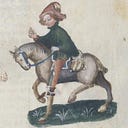Member-only story
How a 17th-Century Female Pickpocket Defied Gender Norms
In recent history, long-standing gender norms have been challenged with ever-increasing frequency. Both Lil Nas X and Harry Styles made headlines when they chose to wear dresses publicly, sparking both an outpouring of support alongside some backlash. One can find photographs of people cross-dressing as far back as the 1940s (or even earlier), but it was practised long before the camera had been invented. Meet Mary Frith, also known as ‘Moll Cutpurse’.
If cross-dressing remains controversial today, it’s no surprise that it was a taboo practice four hundred years ago — but there was quite a lot of it. In his Description of England (1577), clergyman William Harrison lamented that ‘women are become men’ by wearing traditionally male attire, and ‘I have met with some of these trulls in London so disguised that it hath passed my skill to discern whether they were men or women.’ The reasons for cross-dressing varied. Some women would have simply preferred the fit and/or style of male clothes. At least some cross-dressers were almost certainly transgender — one 14th-century sex worker went by both “John” and “Eleanor” — though it is impossible to know for sure. In addition to any other reason, some may have simply revelled in the act as a statement of rebellion.
